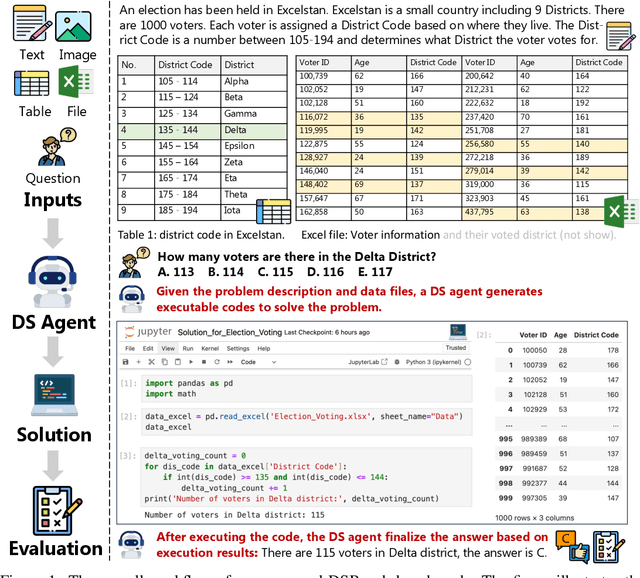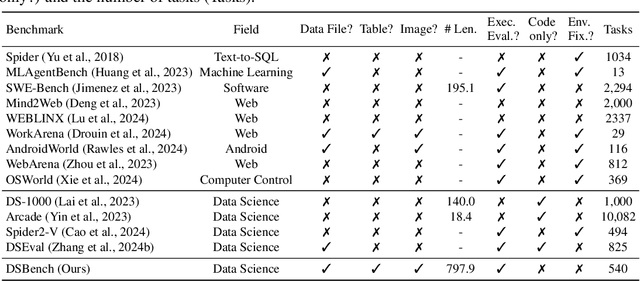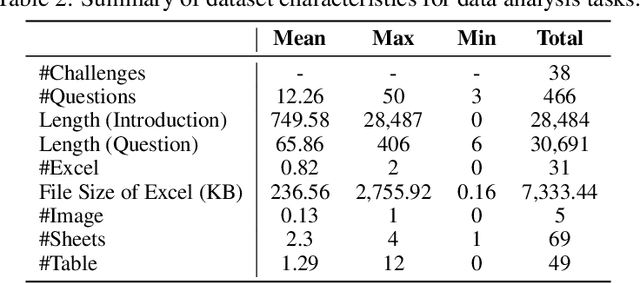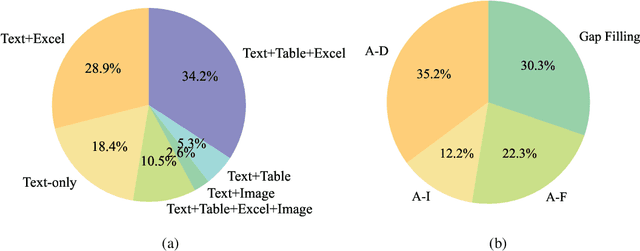Hongming Zhang
Shammie
OpenCharacter: Training Customizable Role-Playing LLMs with Large-Scale Synthetic Personas
Jan 26, 2025



Abstract:Customizable role-playing in large language models (LLMs), also known as character generalization, is gaining increasing attention for its versatility and cost-efficiency in developing and deploying role-playing dialogue agents. This study explores a large-scale data synthesis approach to equip LLMs with character generalization capabilities. We begin by synthesizing large-scale character profiles using personas from Persona Hub and then explore two strategies: response rewriting and response generation, to create character-aligned instructional responses. To validate the effectiveness of our synthetic instruction tuning data for character generalization, we perform supervised fine-tuning (SFT) using the LLaMA-3 8B model. Our best-performing model strengthens the original LLaMA-3 8B Instruct model and achieves performance comparable to GPT-4o models on role-playing dialogue. We release our synthetic characters and instruction-tuning dialogues to support public research.
$β$-DQN: Improving Deep Q-Learning By Evolving the Behavior
Jan 01, 2025Abstract:While many sophisticated exploration methods have been proposed, their lack of generality and high computational cost often lead researchers to favor simpler methods like $\epsilon$-greedy. Motivated by this, we introduce $\beta$-DQN, a simple and efficient exploration method that augments the standard DQN with a behavior function $\beta$. This function estimates the probability that each action has been taken at each state. By leveraging $\beta$, we generate a population of diverse policies that balance exploration between state-action coverage and overestimation bias correction. An adaptive meta-controller is designed to select an effective policy for each episode, enabling flexible and explainable exploration. $\beta$-DQN is straightforward to implement and adds minimal computational overhead to the standard DQN. Experiments on both simple and challenging exploration domains show that $\beta$-DQN outperforms existing baseline methods across a wide range of tasks, providing an effective solution for improving exploration in deep reinforcement learning.
Attention Entropy is a Key Factor: An Analysis of Parallel Context Encoding with Full-attention-based Pre-trained Language Models
Dec 21, 2024



Abstract:Large language models have shown remarkable performance across a wide range of language tasks, owing to their exceptional capabilities in context modeling. The most commonly used method of context modeling is full self-attention, as seen in standard decoder-only Transformers. Although powerful, this method can be inefficient for long sequences and may overlook inherent input structures. To address these problems, an alternative approach is parallel context encoding, which splits the context into sub-pieces and encodes them parallelly. Because parallel patterns are not encountered during training, naively applying parallel encoding leads to performance degradation. However, the underlying reasons and potential mitigations are unclear. In this work, we provide a detailed analysis of this issue and identify that unusually high attention entropy can be a key factor. Furthermore, we adopt two straightforward methods to reduce attention entropy by incorporating attention sinks and selective mechanisms. Experiments on various tasks reveal that these methods effectively lower irregular attention entropy and narrow performance gaps. We hope this study can illuminate ways to enhance context modeling mechanisms.
OpenWebVoyager: Building Multimodal Web Agents via Iterative Real-World Exploration, Feedback and Optimization
Oct 25, 2024



Abstract:The rapid development of large language and multimodal models has sparked significant interest in using proprietary models, such as GPT-4o, to develop autonomous agents capable of handling real-world scenarios like web navigation. Although recent open-source efforts have tried to equip agents with the ability to explore environments and continuously improve over time, they are building text-only agents in synthetic environments where the reward signals are clearly defined. Such agents struggle to generalize to realistic settings that require multimodal perception abilities and lack ground-truth signals. In this paper, we introduce an open-source framework designed to facilitate the development of multimodal web agent that can autonomously conduct real-world exploration and improve itself. We first train the base model with imitation learning to gain the basic abilities. We then let the agent explore the open web and collect feedback on its trajectories. After that, it further improves its policy by learning from well-performing trajectories judged by another general-purpose model. This exploration-feedback-optimization cycle can continue for several iterations. Experimental results show that our web agent successfully improves itself after each iteration, demonstrating strong performance across multiple test sets.
ParallelSpec: Parallel Drafter for Efficient Speculative Decoding
Oct 08, 2024Abstract:Speculative decoding has proven to be an efficient solution to large language model (LLM) inference, where the small drafter predicts future tokens at a low cost, and the target model is leveraged to verify them in parallel. However, most existing works still draft tokens auto-regressively to maintain sequential dependency in language modeling, which we consider a huge computational burden in speculative decoding. We present ParallelSpec, an alternative to auto-regressive drafting strategies in state-of-the-art speculative decoding approaches. In contrast to auto-regressive drafting in the speculative stage, we train a parallel drafter to serve as an efficient speculative model. ParallelSpec learns to efficiently predict multiple future tokens in parallel using a single model, and it can be integrated into any speculative decoding framework that requires aligning the output distributions of the drafter and the target model with minimal training cost. Experimental results show that ParallelSpec accelerates baseline methods in latency up to 62% on text generation benchmarks from different domains, and it achieves 2.84X overall speedup on the Llama-2-13B model using third-party evaluation criteria.
SePPO: Semi-Policy Preference Optimization for Diffusion Alignment
Oct 07, 2024



Abstract:Reinforcement learning from human feedback (RLHF) methods are emerging as a way to fine-tune diffusion models (DMs) for visual generation. However, commonly used on-policy strategies are limited by the generalization capability of the reward model, while off-policy approaches require large amounts of difficult-to-obtain paired human-annotated data, particularly in visual generation tasks. To address the limitations of both on- and off-policy RLHF, we propose a preference optimization method that aligns DMs with preferences without relying on reward models or paired human-annotated data. Specifically, we introduce a Semi-Policy Preference Optimization (SePPO) method. SePPO leverages previous checkpoints as reference models while using them to generate on-policy reference samples, which replace "losing images" in preference pairs. This approach allows us to optimize using only off-policy "winning images." Furthermore, we design a strategy for reference model selection that expands the exploration in the policy space. Notably, we do not simply treat reference samples as negative examples for learning. Instead, we design an anchor-based criterion to assess whether the reference samples are likely to be winning or losing images, allowing the model to selectively learn from the generated reference samples. This approach mitigates performance degradation caused by the uncertainty in reference sample quality. We validate SePPO across both text-to-image and text-to-video benchmarks. SePPO surpasses all previous approaches on the text-to-image benchmarks and also demonstrates outstanding performance on the text-to-video benchmarks. Code will be released in https://github.com/DwanZhang-AI/SePPO.
DivScene: Benchmarking LVLMs for Object Navigation with Diverse Scenes and Objects
Oct 03, 2024



Abstract:Object navigation in unknown environments is crucial for deploying embodied agents in real-world applications. While we have witnessed huge progress due to large-scale scene datasets, faster simulators, and stronger models, previous studies mainly focus on limited scene types and target objects. In this paper, we study a new task of navigating to diverse target objects in a large number of scene types. To benchmark the problem, we present a large-scale scene dataset, DivScene, which contains 4,614 scenes across 81 different types. With the dataset, we build an end-to-end embodied agent, NatVLM, by fine-tuning a Large Vision Language Model (LVLM) through imitation learning. The LVLM is trained to take previous observations from the environment and generate the next actions. We also introduce CoT explanation traces of the action prediction for better performance when tuning LVLMs. Our extensive experiments find that we can build a performant LVLM-based agent through imitation learning on the shortest paths constructed by a BFS planner without any human supervision. Our agent achieves a success rate that surpasses GPT-4o by over 20%. Meanwhile, we carry out various analyses showing the generalization ability of our agent.
LEOPARD : A Vision Language Model For Text-Rich Multi-Image Tasks
Oct 02, 2024Abstract:Text-rich images, where text serves as the central visual element guiding the overall understanding, are prevalent in real-world applications, such as presentation slides, scanned documents, and webpage snapshots. Tasks involving multiple text-rich images are especially challenging, as they require not only understanding the content of individual images but reasoning about inter-relationships and logical flows across multiple visual inputs. Despite the importance of these scenarios, current multimodal large language models (MLLMs) struggle to handle such tasks due to two key challenges: (1) the scarcity of high-quality instruction tuning datasets for text-rich multi-image scenarios, and (2) the difficulty in balancing image resolution with visual feature sequence length. To address these challenges, we propose \OurMethod, a MLLM designed specifically for handling vision-language tasks involving multiple text-rich images. First, we curated about one million high-quality multimodal instruction-tuning data, tailored to text-rich, multi-image scenarios. Second, we developed an adaptive high-resolution multi-image encoding module to dynamically optimize the allocation of visual sequence length based on the original aspect ratios and resolutions of the input images. Experiments across a wide range of benchmarks demonstrate our model's superior capabilities in text-rich, multi-image evaluations and competitive performance in general domain evaluations.
Cognitive Kernel: An Open-source Agent System towards Generalist Autopilots
Sep 16, 2024



Abstract:We introduce Cognitive Kernel, an open-source agent system towards the goal of generalist autopilots. Unlike copilot systems, which primarily rely on users to provide essential state information (e.g., task descriptions) and assist users by answering questions or auto-completing contents, autopilot systems must complete tasks from start to finish independently, which requires the system to acquire the state information from the environments actively. To achieve this, an autopilot system should be capable of understanding user intents, actively gathering necessary information from various real-world sources, and making wise decisions. Cognitive Kernel adopts a model-centric design. In our implementation, the central policy model (a fine-tuned LLM) initiates interactions with the environment using a combination of atomic actions, such as opening files, clicking buttons, saving intermediate results to memory, or calling the LLM itself. This differs from the widely used environment-centric design, where a task-specific environment with predefined actions is fixed, and the policy model is limited to selecting the correct action from a given set of options. Our design facilitates seamless information flow across various sources and provides greater flexibility. We evaluate our system in three use cases: real-time information management, private information management, and long-term memory management. The results demonstrate that Cognitive Kernel achieves better or comparable performance to other closed-source systems in these scenarios. Cognitive Kernel is fully dockerized, ensuring everyone can deploy it privately and securely. We open-source the system and the backbone model to encourage further research on LLM-driven autopilot systems.
DSBench: How Far Are Data Science Agents to Becoming Data Science Experts?
Sep 12, 2024



Abstract:Large Language Models (LLMs) and Large Vision-Language Models (LVLMs) have demonstrated impressive language/vision reasoning abilities, igniting the recent trend of building agents for targeted applications such as shopping assistants or AI software engineers. Recently, many data science benchmarks have been proposed to investigate their performance in the data science domain. However, existing data science benchmarks still fall short when compared to real-world data science applications due to their simplified settings. To bridge this gap, we introduce DSBench, a comprehensive benchmark designed to evaluate data science agents with realistic tasks. This benchmark includes 466 data analysis tasks and 74 data modeling tasks, sourced from Eloquence and Kaggle competitions. DSBench offers a realistic setting by encompassing long contexts, multimodal task backgrounds, reasoning with large data files and multi-table structures, and performing end-to-end data modeling tasks. Our evaluation of state-of-the-art LLMs, LVLMs, and agents shows that they struggle with most tasks, with the best agent solving only 34.12% of data analysis tasks and achieving a 34.74% Relative Performance Gap (RPG). These findings underscore the need for further advancements in developing more practical, intelligent, and autonomous data science agents.
 Add to Chrome
Add to Chrome Add to Firefox
Add to Firefox Add to Edge
Add to Edge